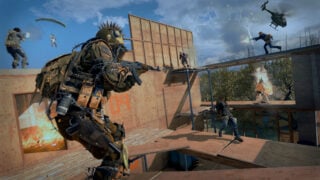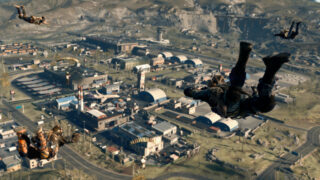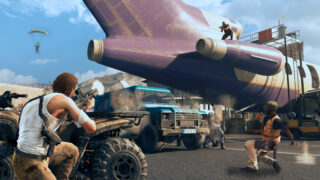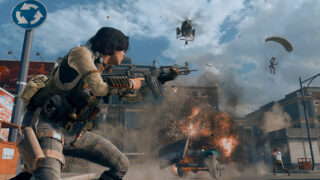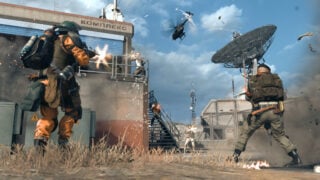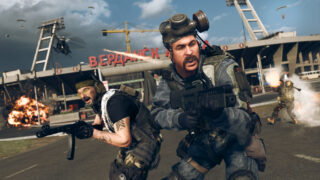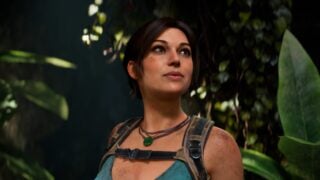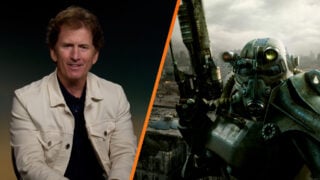#Verdansk has officially been nuked!
— Warzone News (@Warzone2News) April 21, 2021
Here's a better look at the nuke in Warzone:pic.twitter.com/OFLY9myuVE
Warzone Interview: ‘Verdansk 84 is just the beginning… there’s a lot coming’
Raven and Treyarch discuss the future of Call of Duty Warzone and its combination with annual releases
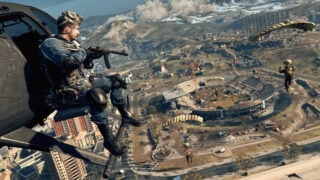
After a full year of in-game hints and community speculation, Call of Duty Warzone finally dropped the bomb on its Verdansk map this week.
Following a 24-hour in-game event which saw the battle royale map obliterated in a fiery explosion, players were eventually transported back in time to the 1980s and dropped into Verdansk 84, a revamped environment featuring five new points of interest and more than a dozen others that have been revamped to tie in with Black Ops Cold War.
Developers Raven and Treyarch claim it’s Warzone’s biggest update ever. But for the Call of Duty series, it represents an even bigger milestone, as the free-to-play title unites the narratives of its two biggest sub-series for the first time outside of its mobile spin-off.
More Call of Duty:
MW3 best loadout | Best Warzone loadout | MW3 best sniper | MW3 best shotgun | MW3 MCW loadout
“I think we have a huge opportunity that we’re only fully realising between the two games,” Treyarch’s creative specialist Miles Leslie told VGC. “Nobody [else] can really do that, and that comes with a lot of pressure to do it right between Warzone and Cold War specifically, in the premium offering that you’re saying.”
Raven’s creative director, Amos Hodge described the “crazy” growth going on behind the scenes, as the former support studio rises to the challenge of taking over live support for Warzone, in addition to its “normal” Call of Duty role on the annual release games.
“I can tell you we’ve been hiring like crazy at Raven,” he said. “All the studios are helping on it, but it’s also additional to our normal Call of Duty schedule. We have a normal Call of Duty schedule and this is on top of that, so we’ve had to grow really fast.”
Read on for our full interview with Raven and Treyarch, as they discuss Verdansk 84, Warzone’s ongoing relationship with annual release games, and how it felt to see users asking Boris Johnson to nerf the dreaded DMR.
Verdansk 84 is here with big additions and changes to the Warzone map. Are we right in thinking the map is the same size?
Hodge: Yes, it’s the same size. I would say it’s a little more packed with stuff because we took a lot of the open spaces and added more stuff to them. We found that players were running across open spaces too much, and when you get killed running across an open space – especially when you’re away from the gas – that’s not the best experience. So we definitely tried to add locations where there was nothing before, and cable cars so that players could get across open spaces with cover. So it’s the same size, but it’s denser.
How did you decide which areas to keep from the original map, and which to revamp?
Hodge: There are a couple of ways we went about it. One way was deciding which Black Ops maps fans loved and wanted to see. Summit comes to mind right away, so then you think where that fits in and clearly, Dam was somewhere. So that’s one direction we went.
The other direction was thinking of which areas didn’t play as well as we’d like. Quarry comes to mind with the buildings that you can’t get in to, plus it was sunk too deep so you kind of felt like you were in a death pit. Superstore was another one, where it felt too campy: players were always hiding in there and you couldn’t really get them out.
So we wanted to clean those places up, add quality of life improvements for areas we thought we could tweak a little bit and make the gameplay really stand out.
Considering your well-documented battle with file sizes, a lot of players will be wondering if they’ll need to invest in a new hard drive for Verdansk 84?
Hodge: We just did an update with Season 2 that reduced the file size by quite a bit. We’re continually updating that, we recently added the feature allowing you to select which sections of the game you’ve downloaded, because really… it’s the amount of content – single-player, zombies, multiplayer – and not just one game, it’s like four games.
So allowing players to unload certain sections of the game, like if you’re done with single-player… and we’re continually working on file size. We know it’s an issue, we’re players too, it’s on my hard drive, we’re constantly working on it… you’ll see it get better.
In the past, you might have launched a new battle royale with each premium CoD release, but Warzone is now aligning with its second ‘premium’ game. Is the plan to keep evolving Warzone for years to come?
Hodge: Yeah, we view Warzone as a live service. It’s our free-to-play offering: we think of it as a way to bring in new players, get them acclimated to the universe… it’s a great offering for players and we’re trying to keep it continually updated. That’s the plan going forward.
Leslie: I think we have a huge opportunity that we’re only fully realising between the two games. Nobody [else] can really do that, and that comes with a lot of pressure to do it right between Warzone and Cold War specifically, in the premium that you’re saying.
But there’s a lot of cool stuff we could do there. Like Amos was saying, there’s an evolution and an iteration of like, ‘this could be cool, that nobody else could do except us’ and that’s really exciting, where we can take it into the future as well.
“We view Warzone as a live service. It’s our free-to-play offering: we think of it as a way to bring in new players, get them acclimated to the universe… it’s a great offering for players and we’re trying to keep it continually updated. That’s the plan going forward.”
Warzone’s nuke event has been hinted at in-game since launch. It seems like it’s required a significant amount of investment to plan a live event of this scale?
Hodge: Yeah, it’s a lot of work and it’s a big experiment for us. If you remember, we did a Cold War reveal where it was something similar; a limited-time special game, like an experience… they went on a scavenger hunt, they found Woods and players really liked that.
That was really our first experiment of doing something that was a lot of work, but also not replayable. Most of our work – weapons, maps and game modes – can be reused a lot, but that was our first experiment and players really loved that. That was our best reveal ever… so basically, we took that, and asked, ‘how can we crank that up and do it again?’
This is going even deeper. It has that same vibe of, ‘here’s a moment in time, it’s going to be cool, it’s going to be amazing, players are not really going to know what’s happening’, and we’re gauging to see if the payoff is worth it. Because that work does get thrown away, so we have to be conscious as developers of where we put our resources.
So it’s kind of an experiment for us, because we want to tie the narrative and the gameplay together and we feel like this will really hit a home run. And we hope it does, and we hope to do more things like this, but we are very data-driven. So if players like it, cool: we’ll do more of it. Do they not like it? OK, we’ll do less of that. Just like they grabbed onto the Cold War event, so we’re going to do more events like that.
I’m just excited to see the community reaction, and if it takes off, because really that all determines our future schedule, right? Do we do more stuff like this, or less stuff like this? It’s all about what players want.

Verdansk 84 finally aligns the Warzone map with Cold War, but it’s arrived six months after the main game. Was that always the plan?
Hodge: With Warzone we’re in uncharted territory. This is our first time doing free-to-play, it’s our first time doing battle pass, it’s our first time connecting to a second game… so when we launched we were careful not to bite off more than we could chew.
It was really important to us that players were connected across both games with progression and weapons, so that they could play either game and feel like they were making progress. We also wanted to connect the narrative and the story.
So it was just like the reveal event, where we’re just trying stuff out for the first time. We’re just experimenting and we’re going to see how it goes. We think players will love it and we think they’ll want more of it, but we don’t know. We hope this goes well and players love the connection of the narrative and gameplay, and we’ll just keep doing more of it, but really this is an experiment for us, to be honest.
We really think it’s the way to go and we think players will love it, but… there’s no other game that’s doing this. It’s just kind of crazy for us.
Should we expect tighter alignment with premium releases going forward?
Hodge: What we’re seeing is that players love to go between both games. They’re playing both games almost in equal amounts. They’re different experiences and people love to go between them, and so the more closely we can connect the story, the narrative and the weapons, so they can take their progress back and forth… the more players are happy. That way they feel like it’s one game… that’s where we’ve seen the most success. The more we connect it, the more players love it.
Leslie: As Amos said, it’s really [about] what players respond to. We have loose, ‘hey, this would be cool’ ideas, but it’s really like if players also thought that was cool. You can’t plan so far in the future without playtesting and also seeing the real world [reaction] as well. We know we want to do more, we’ll see how they respond, but we’ve also got some tricks up our sleeve, even within Season 3… this is huge for the start, but there’s also more to come that we’ll see how players respond to as well.
Hodge: There are players who just care about gameplay but don’t care about story, and there are players who care about the story but they’re not that into gameplay. When we mix them both, it gives people a crossing over and just makes it stronger. That’s our goal here, to get both audiences with story and gameplay elements combined.
A good example is you’re going to see the iconic Cold War red doors show up in Season 3 and that is a narrative, story element from Cold War. But also you’re going to see some cool gameplay tied to it. So hopefully if you’re not interested in the story, you’ll be like, ‘oh cool, what is this?’ and then you figure out the story of the red doors, or if you care about the story of the red doors you’ll discover that there’s some cool gameplay tied to this. So we’re really trying to service both types of players with one event.
You’ve talked a lot about reacting to the community, but with the huge lead times required to create this content, how flexible can you realistically be to community opinion?
Hodge: That depends on the content. Things like maps – so, Verdansk 84 – is not something you can do in three weeks. But we can update weapon balance, we can fix bugs… game modes, depending on the scope, you can do crazy game modes but you can also do smaller scope modes a little quicker.
But anything that involves art and animation like a weapon pipeline is really long. We can make balance changes, but we can’t make a brand new weapon super fast, because there’s art, there’s animation, there are textures, there’s sound, effects… But modes, balance changes, playlist changes, game mode changes – those things we can make faster and we tend to do that.
With Season 3 you’ll see a shift in the meta away from burst guns, and we’ll get the FFAR – which has been stomping on some of the SMGs lately – back down so the SMGs can shine again.

Leslie: I think a big part of this is that it takes time to playtest and find the fun and that’s a huge part of this. Amos is 100% dialled in to all the gameplay and he knows that if you release something that’s not fun, you’re going to do more damage. That’s the key for us: find the fun that players can strive and engage with.
But there’s also different types of fun and different types of player; casual, hardcore, care about story, don’t care about story, multiplayer, zombies, Warzone… so we’re constantly finding the right way to push each of those different players and see what they like, and what they don’t like across both titles. Because that gives us a compass: ‘they’re liking this, they’re liking that’ and that’s constantly an iterative process overall.
You’ve had a year to catch up with Warzone’s breakout success. Should players expect more significant content going forwards?
Hodge: Yeah. As long as people keep playing, we’re going to keep making content. That’s the only way we keep making content: if players keep playing. I will say that a lot of the stuff you’ve seen today was just the beginning: we could do a whole other presentation on the mid-season update… there’s a lot of content coming in 3.5. This is our biggest season to date.
This is just the launch stuff: we’re doing new content, we keep growing our team size… it’s crazy. I just love our playerbase: they’re excited, they’re passionate and I love making new content for them.
Development-wise, how much has changed behind the scenes in 12 months?
Hodge: I can tell you we’ve been hiring like crazy at Raven. We have jobs posted all over the place and we’re looking for new talent. If any of your readers out there are interested… we have more ideas than we can do! Warzone was a smash hit success. All the studios are helping on it, but it’s also additional to our normal Call of Duty schedule. We have a normal Call of Duty schedule and this is on top of that, so we’ve had to grow really fast.
“I will say that a lot of the stuff you’ve seen today was just the beginning: we could do a whole other presentation on the mid-season update… there’s a lot of content coming in 3.5. This is our biggest season to date.”
And it’s also brought us a new type of player. Because you get those free-to-play players or battle royale players who traditionally don’t want to spend $60 for TDM. So we’re getting a new type of player and we have to think about that player more and how that changes the content in Warzone. It’s been a great learning and design experience and we’re growing. We’re just trying to keep up as fast as we can… it’s honestly been just crazy.
Leslie: Amos has servers literally behind him right now!
What opportunities does the 80s time period represent that you’re excited about?
Leslie: It’s huge. When we’re slamming these narratives and worlds together, you’re already keying off it and we hope that players do as well, is that the opportunities when the worlds are colliding, the narratives are one and we’re on a single track allow us to go in some interesting directions with game modes, operators, weapons and all these things.
There are a lot of opportunities to lean into 1984 and the tech of that era, the attitude of that era with the music and culture as well… there’s a lot there. We’re definitely leaning into it and the map itself going into spring is part of that as well, feeling like a fresh, new take.
Hodge: I’d like to point out that in the slides we showed you [earlier], there was a little “classified” section for “80s Action”… there is some cool stuff we’ve got planned for the 80s, so feel free to speculate on that. The 80s is full of stuff from War Tracks, to weapons and the cool colour palette. I think it really changes the mood of Verdansk 84: it feels different and fresh.

What elements of the old map will you miss the most? And would you consider bringing them back one day, perhaps as part of a limited-time playlist?
Hodge: We’ve put Standoff in the old Farms location, which is tough because I love the Farms location but I also love Standoff… it still kind of has the same vibe. I know Farms wasn’t super popular, but for me it was the perfect mix of… there weren’t too many players there, but there was enough loot for me personally.
I don’t like to go to the super dense areas, but I don’t like to go to the empty areas either and so this had that little mix. If you dropped there early, you’d get people coming out of the Gulag for easy kills and you could gear up fast, and there was usually a helicopter nearby… that has been my go-to drop point that got replaced.
Leslie: That’s a hard one. I liked the Quarry and death pit nature of it, because I like fast-paced CQC. That was my go-to spot, but now there’s more cover there so it’s harder for me to mow down people. But the funny thing is I’ve been playtesting Verdansk 84 so much that now I like it, because I’m finding new ways to slay.
I do think players will be like, ‘I miss being able to do this’, but then they’re going to find a new way to do that thing, like the gondola lifts in Summit, or the Salt Mines that have these little hills that you can climb. I bet you they’re going to be like, ‘Quarry what? Dam what? This is the new hotness’ because it offers so much more new gameplay.
Hodge: That’s a good point: although Farms was where I liked to drop, now I’m always dropping in Summit. Even if Farms was still there, I would still drop in Summit.
Leslie: The best thing is, we actually have arguments over where people like to drop internally and that’s when you know that you’ve got something… when everybody’s mad at each other.
“There are a lot of opportunities to lean into 1984 and the tech of that era, the attitude of that era with the music and culture as well… there’s a lot there. We’re definitely leaning into it and the map itself going into spring is part of that as well, feeling like a fresh, new take.”
Cheating has been a big issue since launch. What measures are you taking to combat cheating going forward?
Hodge: Cheating is not something my team handles. I’m the gameplay guy: weapons, maps, game modes… I’m your guy [for that]. Cheating is handled by our security team. But what I will say is that we have reporting tools, we ban a ton of people and no one hates the cheaters more than we do. We make this content for the players and while you’re upset that it ruined your game, I’m upset that it’s ruining some of the best work that I’ve done in my life.
I made this content for players and I know that everyone around the team feels that way. We put our hearts into this content, we have 100 million players, it’s been out a year, this is a huge stage and some of the best work we’ve ever done, and to have cheaters come in and ruin the game bothers us more than anyone. I know the security team are on top of it and they’re continually going to make updates.
You mentioned moving away from the current burst gun meta. At which point do you consider a gun to cross the line from popular, to overpowered and requiring action?
Hodge: That’s a combination of things, but mostly it’s data-driven. We actually have data so we know how many players are using each weapon and we will look at what players are putting in their loadout kits, collect that data and then we have a range where if above a certain percentage of players are using something then it’s out of control.
We have a range of not just each gun, but each class. Because if 80 percent of players were using SMGs then we’d see that as a problem. And then you can dig in and see are the majority of those players only using one type of SMG? We really look at the numbers, and then we look at the community sentiment and take that into account too.

With so many guns – we’re nearing close to 100 – there’s always going to be one or two that are the best and part of the meta, but we want to make sure that we’re constantly changing that so the meta doesn’t get stale and boring. If the meta was still the M4 from when we launched, it would be boring.
So we know there’s always going to be one or two guns that are in the meta – and it’s usually a long-range gun and a short-range gun – and we want a meta: we want people to know and learn new experiences, but we don’t want it to set too long. Our goal is to change it every season launch. We might not always hit that, because it’s not like a science, it’s an art.
But our goal is to try and shift up the meta with every season launch and then we’ll fix bugs and try and let it set, see where it goes, and hopefully it becomes stable and lasts for a good half a season, then the next season we can change it up. Our seasons are typically around two months long, so we figure that’s a good time for a meta to evolve, players get comfortable with it and then are ready for the new one. That’s our goal, but we’re very data-driven and we’re always looking at the stats.
How painful was it watching the DMR dominate during your Christmas break last year? Even people in the UK Prime Ministers’ press conference streams were calling for a nerf.
Leslie: You can let him know that the Queen actually asked for that buff, so…
Hodge: I think that goes to show you the popularity of Warzone. That’s what surprised me: everyone was asking about it and it gave me a sense of how crazy big Warzone is. A lot of times I just get lost in work at the office, I live in a small town in Wisconsin and that’s my world, then all of sudden you realise this is a worldwide game and it takes you out of that.
A lot of times you look at the numbers: We’ve hit 100 million players, which is a large number but doesn’t always sink in until stuff starts hitting the news waves. It was surreal to have stuff like that happen.






